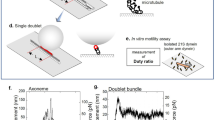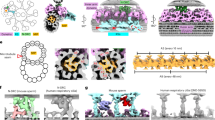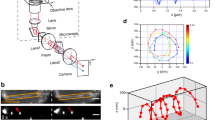Abstract
Dyneins are large microtubule motor proteins required for mitosis, intracellular transport and ciliary and flagellar motility1,2. They generate force through a power-stroke mechanism, which is an ATP-consuming cycle of pre- and post-power-stroke conformational changes that cause relative motion between different dynein domains3,4,5. However, key structural details of dynein’s force generation remain elusive. Here, using cryo-electron tomography of intact, active (that is, beating), rapidly frozen sea urchin sperm flagella, we determined the in situ three-dimensional structures of all domains of both pre- and post-power-stroke dynein, including the previously unresolved linker and stalk of pre-power-stroke dynein. Our results reveal that the rotation of the head relative to the linker is the key action in dynein movement, and that there are at least two distinct pre-power-stroke conformations: pre-I (microtubule-detached) and pre-II (microtubule-bound). We provide three-dimensional reconstructions of native dyneins in three conformational states, in situ, allowing us to propose a molecular model of the structural cycle underlying dynein movement.
This is a preview of subscription content, access via your institution
Access options
Subscribe to this journal
Receive 12 print issues and online access
$209.00 per year
only $17.42 per issue
Buy this article
- Purchase on Springer Link
- Instant access to full article PDF
Prices may be subject to local taxes which are calculated during checkout





Similar content being viewed by others
References
Hook, P. & Vallee, R. B. The dynein family at a glance. J. Cell Sci. 119, 4369–4371 (2006).
Gibbons, I. R. & Rowe, A. J. Dynein: A protein with adenosine triphosphatase activity from cilia. Science 149, 424–426 (1965).
Johnson, K. A. Pathway of the microtubule-dynein ATPase and the structure of dynein: A comparison with actomyosin. Annu. Rev. Biophys. Biophys. Chem. 14, 161–188 (1985).
Kon, T. et al. Helix sliding in the stalk coiled coil of dynein couples ATPase and microtubule binding. Nat. Struct. Mol. Biol. 16, 325–333 (2009).
Tsygankov, D., Serohijos, A. W., Dokholyan, N. V. & Elston, T. C. Kinetic models for the coordinated stepping of cytoplasmic dynein. J. Chem. Phys. 130 (2009).
Summers, K. E. & Gibbons, I. R. Adenosine triphosphate-induced sliding of tubules in trypsin-treated flagella of sea-urchin sperm. Proc. Natl Acad. Sci. USA 68, 3092–3096 (1971).
King, S. M. Integrated control of axonemal dynein AAA(+) motors. J. Struct. Biol. 179, 222–228 (2012).
Fliegauf, M., Benzing, T. & Omran, H. When cilia go bad: cilia defects and ciliopathies. Nat. Rev. Mol. Cell Biol. 8, 880–893 (2007).
Eschbach, J. & Dupuis, L. Cytoplasmic dynein in neurodegeneration. Pharmacol. Ther. 130, 348–363 (2011).
Cho, C. & Vale, R. D. The mechanism of dynein motility: insight from crystal structures of the motor domain. Biochim. Biophys. Acta 1823, 182–191 (2012).
Kon, T. et al. The 2.8 Å crystal structure of the dynein motor domain. Nature 484, 345–350 (2012).
Schmidt, H., Gleave, E. S. & Carter, A. P. Insights into dynein motor domain function from a 3.3-Å crystal structure. Nat. Struct. Mol. Biol. 19, 492–497 (2012) S1
Carter, A. P. et al. Structure and functional role of dynein’s microtubule-binding domain. Science 322, 1691–1695 (2008).
King, S. M. The dynein microtubule motor. Biochim. Biophys. Acta 1496, 60–75 (2000).
Burgess, S. A., Walker, M. L., Sakakibara, H., Knight, P. J. & Oiwa, K. Dynein structure and power stroke. Nature 421, 715–718 (2003).
Roberts, A. J. et al. AAA+ Ring and linker swing mechanism in the dynein motor. Cell 136, 485–495 (2009).
Roberts, A. J. et al. ATP-driven remodeling of the linker domain in the dynein motor. Structure 20, 1670–1680 (2012).
Movassagh, T., Bui, K. H., Sakakibara, H., Oiwa, K. & Ishikawa, T. Nucleotide-induced global conformational changes of flagellar dynein arms revealed by in situ analysis. Nat. Struct. Mol. Biol. 17, 761–767 (2010).
Mizuno, N., Taschner, M., Engel, B. D. & Lorentzen, E. Structural studies of ciliary components. J. Mol. Biol. 422, 163–180 (2012).
Nicastro, D. et al. The molecular architecture of axonemes revealed by cryoelectron tomography. Science 313, 944–948 (2006).
Heumann, J. M., Hoenger, A. & Mastronarde, D. N. Clustering and variance maps for cryo-electron tomography using wedge-masked differences. J. Struct. Biol. 175, 288–299 (2011).
Bouchard, P., Penningroth, S. M., Cheung, A., Gagnon, C. & Bardin, C. W. Erythro-9-[3-(2-hydroxynonyl)]adenine is an inhibitor of sperm motility that blocks dynein ATPase and protein carboxylmethylase activities. Proc. Natl Acad. Sci. USA 78, 1033–1036 (1981).
Ueno, H., Yasunaga, T., Shingyoji, C. & Hirose, K. Dynein pulls microtubules without rotating its stalk. Proc. Natl Acad. Sci. USA 105, 19702–19707 (2008).
Mallik, R., Carter, B. C., Lex, S. A., King, S. J. & Gross, S. P. Cytoplasmic dynein functions as a gear in response to load. Nature 427, 649–652 (2004).
Sakakibara, H., Kojima, H., Sakai, Y., Katayama, E. & Oiwa, K. Inner-arm dynein c of Chlamydomonas flagella is a single-headed processive motor. Nature 400, 586–590 (1999).
Moss, A. G., Sale, W. S., Fox, L. A. & Witman, G. B. The alpha subunit of sea urchin sperm outer arm dynein mediates structural and rigor binding to microtubules. J. Cell Biol. 118, 1189–1200 (1992).
Qiu, W. et al. Dynein achieves processive motion using both stochastic and coordinated stepping. Nat. Struct. Mol. Biol. 19, 193–200 (2012).
Yildiz, A., Tomishige, M., Vale, R. D. & Selvin, P. R. Kinesin walks hand-over-hand. Science 303, 676–678 (2004).
Huang, J., Roberts, A. J., Leschziner, A. E. & Reck-Peterson, S. L. Lis1 acts as a ‘clutch’ between the ATPase and microtubule-binding domains of the dynein motor. Cell 150, 975–986 (2012).
Rompolas, P., Patel-King, R. S. & King, S. M. Association of Lis1 with outer arm dynein is modulated in response to alterations in flagellar motility. Mol. Biol. Cell 23, 3554–3565 (2012).
Linck, R. W. & Stephens, R. E. Functional protofilament numbering of ciliary, flagellar, and centriolar microtubules. Cell Motil. Cytoskeleton 64, 489–495 (2007).
Gibbons, I. R. Sliding and bending in sea urchin sperm flagella. Symp. Soc. Exp. Biol. 35, 225–287 (1982).
Heuser, T., Raytchev, M., Krell, J., Porter, M. E. & Nicastro, D. The dynein regulatory complex is the nexin link and a major regulatory node in cilia and flagella. J. Cell Biol. 187, 921–933 (2009).
Witman, G. B., Carlson, K., Berliner, J. & Rosenbaum, J. L. Chlamydomonas flagella I Isolation and electrophoretic analysis of microtubules, matrix, membranes, and mastigonemes. J. Cell Biol. 54, 507–539 (1972).
Iancu, C. V. et al. Electron cryotomography sample preparation using the Vitrobot. Nat. Protoc. 1, 2813–2819 (2006).
Lin, J., Heuser, T., Song, K., Fu, X. & Nicastro, D. One of the nine doublet microtubules of eukaryotic flagella exhibits unique and partially conserved structures. PLoS One 7, e46494 (2012).
Mastronarde, D. N. Automated electron microscope tomography using robust prediction of specimen movements. J. Struct. Biol. 152, 36–51 (2005).
Kremer, J. R., Mastronarde, D. N. & McIntosh, J. R. Computer visualization of three-dimensional image data using IMOD. J. Struct. Biol. 116, 71–76 (1996).
Harauz, G. & Van Heel, M. Exact filters for general geometry three dimensional reconstruction. Optik 73, 146–156 (1986).
Pettersen, E. F. et al. UCSF Chimera–a visualization system for exploratory research and analysis. J. Comput. Chem. 25, 1605–1612 (2004).
Acknowledgements
We thank D. T. N. Chen (Brandeis University) for providing Strongylocentrotus purpuratus sperm; M. Porter (University of Minnesota) for providing the pseudo wild-type Chlamydomonas strain; and C. Xu for providing training and management of the Brandeis EM facility. We are grateful to D. Mitchell (SUNY Upstate Medical University), and J. Gelles, D. DeRosier and T. Heuser (all from Brandeis University) for critically reading the manuscript. This work was supported by financial support from the National Institutes of Health (GM083122 to D.N.).
Author information
Authors and Affiliations
Contributions
D.N. conceived and directed the study. J.L. performed the experiments. J.L., M.R. and D.N. analysed the data. J.L., K.O., M.C.S. and D.N. wrote the manuscript.
Corresponding author
Ethics declarations
Competing interests
The authors declare no competing financial interests.
Integrated supplementary information
Supplementary Figure 1 Distributions of different dynein conformations inside a sea urchin sperm flagellum revealed by classification analysis.
Subtomogram volumes containing the 96 nm axonemal repeat were aligned and classified, focusing on β-ODA. The distributions of the different classified conformations were then mapped back to their locations in the raw tomograms of the sea urchin sperm flagella. Different conformations of β-ODA (and the o-SUB5-6 bridge structures) are indicated by different coloured dots: post-powerstroke (red), pre-II (blue), minor and low resolution classes possibly representing other dynein conformations (orange), o-SUB5-6 bridge structure (green); note that the distribution of identified dynein conformations is highly specific to particular doublets, which is consistent with the precise regulation of dynein activity to generate the flagellar waveform.
Supplementary Figure 2 In situ structures of Chlamydomonas axonemal dyneins in post-powerstroke state as revealed by cryo-ET.
(a) Tomographic slice of an averaged doublet microtubule (DMT) viewed in cross-section from proximal, showing the in situ arrangement of the axonemal dyneins. Coloured lines indicate locations of tomographic slices in b–d and f,g. (b–h’) Longitudinal (parallel to the microtubule) tomographic slices show the averaged axonemal dyneins. e/e’ and h/h’ are zoom-ins from d and g, respectively. In e’ and h’, isosurface-rendered 3D images of averaged α-ODA and IDA dynein c were superimposed on the corresponding tomographic slices (e, h). (i–k) 3D isosurface renderings show the averaged axonemal dyneins. Note that each Chlamydomonas ODA is composed of three dynein heavy chains (α, β, and γ-ODA); the innermost γ-ODA corresponds to the sea urchin α-ODA (compare to Fig. 2). Tail (pink), linker (magenta) and head (green) domains are clearly visible in both tomographic slices and isosurface renderings; coiled-coil stalks (orange arrowheads) are distinct in the tomographic slices (b–d, f). IDA a, b, c, e, g, d are also known as IDA2, x,3,4,5,6, respectively36. Other labels: A-tubule (At), B-tubule (Bt), nexin-dynein regulatory complex (N-DRC), radial spoke (RS), radial spoke 3 stand-in (RS3S). Structure-colour coding is preserved in the isosurface renderings in all following figures. White arrowheads in e, e’, and j highlight an extra density that is specifically attached to the dynein head and tail domains. Scale bars: 10 nm.
Supplementary Figure 3 In situ structural changes of sea urchin IDAs between post- and pre-powerstroke states.
(a–d) 3D isosurface rendering of averaged IDAs showing conformational changes observed for IDA dyneins c and e between post-powerstroke (a, b) and pre-powerstroke (c, d) states. In b and d, the crystal structure of S. cerevisiae cytoplasmic dynein (ribbon representation with AAA1-6 from PDB 4AKI)12 is docked into our IDA EM volume to illustrate changes in the interaction between the linker and head. White arrowheads in c and d highlight an extra density that specifically attaches to the linker and AAA1 in pre-powerstroke states.
Supplementary Figure 4 Comparison between simulated and real 3D structures of dynein in different conformational states.
The averaged 3D cryo-ET structures of two different dynein isoforms (IDA dynein a and β-ODA) in two different conformational states (post- and pre-II-powerstroke states) provide structural details of the relative motion between the AAA-domain head and the linker. The first column on the left shows the x-ray crystal structure of S. cerevisiae cytoplasmic dynein (PDB 4AKI A chain)12. To interpret the relative motions between different conformational states, the crystal structure was cut at the proposed hinge site (arrow heads); the major part of the linker was then aligned (held stationary), while the dynein head and stalk were rotated around the hinge site to the locations predicted by our different cryo-ET structures; the rotation angle between the head and linker increases from top to bottom: IDA a, post-powerstroke (top); β-ODA, post-powerstroke; IDA a, pre-II state; β-ODA; pre-II state (bottom). The second column shows simulated density maps that were generated from the modified x-ray structures using the Chimera molmap command. The third column shows the 3D in situ structures of sea urchin axonemal dyneins (with the major part of their linker aligned) as revealed by cryo-ET. The fourth column shows the same structures as the third, but with the crystal structures from the first column docked into the cryo-ET structures. The linker and tail domains in the cryo-ET structures were coloured in magenta and pink, respectively.
Supplementary information
Supplementary Information
Supplementary Information (PDF 1094 kb)
Live cell DIC light microscopy video of beating Strongylocentrotus (sea urchin) sperm.
This video shows sea urchin sperm, rapidly swimming due to actively beating flagella. In this preparation, freshly harvested sea urchin sperm were diluted in artificial seawater. (AVI 14731 kb)
Live cell DIC light microscopy video of inhibited Strongylocentrotus (sea urchin) sperm.
This video shows immotile sea urchin sperm. In this preparation, freshly harvested sea urchin sperm were diluted in artificial seawater containing the ATPase (dynein) inhibitor EHNA (2 mM). Visible movement of the sea urchin sperm is passive, due to buffer flow. (AVI 12182 kb)
Mechanistic model of dynein movement.
This video combines real electron microscopic data and a schematic model of the powerstroke cycle of dynein. The first part of the video shows three representative tomographic slices of dynein in the post-, pre-I and pre-II powerstroke states. Initially, a schematic outline of dynein is superimposed on each of these slices to highlight conformational changes of dynein domains. The second part of the video highlights the proposed head-rotation mechanism of dynein movement, as described in this study. (AVI 17612 kb)
Rights and permissions
About this article
Cite this article
Lin, J., Okada, K., Raytchev, M. et al. Structural mechanism of the dynein power stroke. Nat Cell Biol 16, 479–485 (2014). https://doi.org/10.1038/ncb2939
Received:
Accepted:
Published:
Issue Date:
DOI: https://doi.org/10.1038/ncb2939
This article is cited by
-
Inhibition of mitochondrial cyclophilin D, a downstream target of glycogen synthase kinase 3α, improves sperm motility
Reproductive Biology and Endocrinology (2024)
-
Versatile properties of dynein molecules underlying regulation in flagellar oscillation
Scientific Reports (2023)
-
Dynamic coupling of fast channel gating with slow ATP-turnover underpins protein transport through the Sec translocon
The EMBO Journal (2023)
-
Curvature in the reproductive tract alters sperm–surface interactions
Nature Communications (2021)
-
In situ structure determination at nanometer resolution using TYGRESS
Nature Methods (2020)



